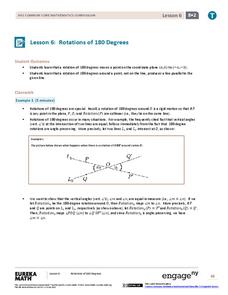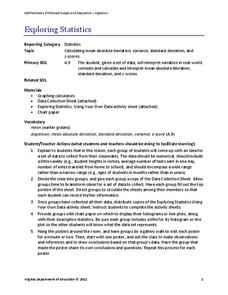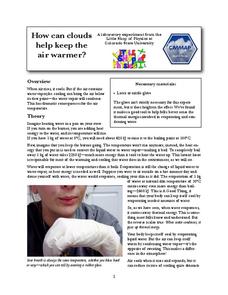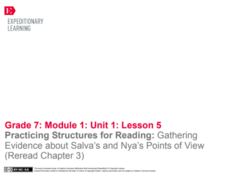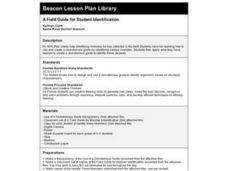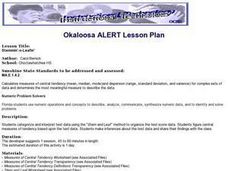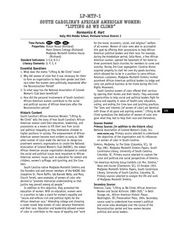Achievement Strategies
CCSS Unpacked Learning Targets for Reading and Writing History/Social Studies
How do all the lessons and activities you have planned for your class align to Common Core State Standards? This can feel like a very daunting question. Help ease the process by referencing a template that not only lists and organizes...
National Woman's History Museum
The National Woman’s Party
Two parties led the women's suffrage movement. The National American Woman Suffrage Association (NAWSA) was a moderate organization while the National Women's Party (NWP) was more militant. Young historians investigate why members of the...
EngageNY
Rotations of 180 Degrees
What happens when rotating an image 180 degrees? The sixth lesson in the series of 18 takes a look at this question. Learners discover the pattern associated with 180-degree rotations. They then use transparency paper to perform the...
Virginia Department of Education
Exploring Statistics
Collect and analyze data to find out something interesting about classmates. Groups devise a statistical question and collect data from their group members. Individuals then create a display of their data and calculate descriptive...
Colorado State University
How Can Clouds Keep the Air Warmer?
Condensing water warms the air around it. Young scholars consider this concept as they experiment with air temperature around evaporating and condensing water vapor. They simulate the formation of clouds to experience the associated...
Open Oregon Educational Resources
How to Learn Like a Pro!
What's the best way to ace an exam or pass a difficult class? Scholars find out using an information-packed eBook. Pupils read about learning styles, study skills, test-taking strategies, and other topics associated with maximizing...
EngageNY
Practicing Structures for Reading: Gathering Evidence about Salva’s and Nya’s Points of View (Reread Chapter 3)
How does an author develop and contrast character points of view in a work of literature? Using a graphic organizer, readers continue gathering evidence about character point of view from Linda Sue Park's A Long Walk to Water. Next,...
Curated OER
A Field Guide for Student Identification
Students create and use a dichotomus guide to identify cartoon monsters and use this skill to further their ability to scientifically classify organisms.
Curated OER
I Need Air
Students examine and research the organs of the respiratory system. They participate in a vocabulary card matching game, create a graphic organizer, and participate in an experiment titled, Floating on Air.
Curated OER
Breaking the Food Chain
Students investigate the food chain. They brainstorm questions about the human food chain and explain what would happen to living things in the food chain if organisms or resources were removed. They role-play situations in which the...
Curated OER
Stemmin'-n-Leafin'
Learners make stem and leaf charts to determine the measures of central tendency using test score data. They analyze the data to draw inferences which they share with the class. They complete the associated worksheets.
Curated OER
What Would You Do Without Nonprofits?
Students research nonprofit organizations within their community. In this nonprofits lesson, students use the yellow pages to identify the number of nonprofit organizations in their community. Students graph the number of nonprofit...
Curated OER
Body by Design: Form and Function
Students study symbiosis and its association in nature. In this organisms lesson plan students divide into groups and research organisms that have a symbiotic relationship.
Curated OER
The Void Filled by Nonprofits
High schoolers examine the significance of nonprofit organizations in a democratic society. They conduct research on a selected nonprofit organization, complete a questionnaire, and present their findings to the class.
Curated OER
Pest Populations: A Game of Survival
Young scholars identify and classify populations of pests in the home, school and community. They recognize the specific conditions needed for the survival of an organism considered a pest and list tactics for control measures.
Curated OER
DNA and Individual Differences
Students list differences between DNA-related terms and create a simple DNA circle map. They order terms including human body, organ, tissue, cell, nucleus, etc. from largest to smallest. They discuss differences and similarities among...
Curated OER
Preventing and Treating Disease
In this disease worksheet, students will review the organs associated with the immune system including their specific functions. This worksheet has 10 matching, 8 true or false, and 5 short answer questions.
Curated OER
It's All in the Making: Our Local Organizations
Students study African American nonprofit organizations. In this nonprofit organizations lesson, students discuss African American organizations. Students research the NAACP and NUL website. Students design posters for both groups....
Curated OER
The Unsung Heroes
Students investigate the unsung heroes associated with local foundations and non-profit organizations. In this unsung heroes lesson, students decide on the characteristics associated with heroes, and research foundations and non-profit...
Curated OER
Comparing Microscopic Organisms in Fresh and Polluted Water: An Invitation To Inquiry
Young scholars have the opportunity to develop and formulate ideas and explanations through the scientific standard of inquiry. They identify organisms by using an identification key for specific aquatic geographical area.
Curated OER
The Brain and the Sense Organs - Lesson Plan
Students identify the five sense organs and state the uses of the five senses.
Curated OER
Simple Organic Compounds
In this organic compounds worksheet, students review 8 terms associated with hydrocarbon molecules. Students find these 8 terms in a word search.
Curated OER
South Carolina's African American Women: "Lifting As We Climb"
Middle schoolers explore the formation of the National Association of colored Women's Club. In this civil rights lesson, students research the history and mission of the NACWC.
Curated OER
Whst Makes You Tick?
Eleventh graders explore the major organs of the circulatory system. In this circulatory system lesson, 11th graders create, identify and describe parts of the system. Students view a list of major organs and predict what their job is....




